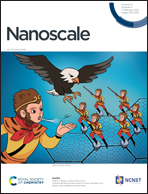Enhancing the hydrogen evolution activity of MoS2 basal planes and edges using tunable carbon-based supports†
Abstract
The hydrogen adsorption free energy (ΔGHads) on the basal plane and edges of MoS2 is studied using periodic density functional theory, with the catalyst supported by a range of two-dimensional carbon-based materials. Understanding how ΔGHads can be tuned with support gives insight into MoS2 as a catalyst for the hydrogen evolution reaction. The supports studied here include graphene oxide materials, heteroatom doped (S, B, and N) graphene, and some insulator materials (hexagonal boron nitride and graphitic carbon nitride). For the basal plane of MoS2, a wide range of values for ΔGHads are observed (between 1.4 and 2.2 eV) depending on the support material used. It is found that ΔGHads relates directly to the energy of occupied p-orbital states in the MoS2 catalyst, which is modified by the support material. On the Mo-edge of MoS2, different supports induce smaller variations in ΔGHads, with values ranging between −0.27 and 0.09 eV. However, a graphene support doped with graphitic N atoms produces a ΔGHads value of exactly 0 eV, which is thermodynamically ideal for hydrogen evolution. Furthermore, ΔGHads is found to relate closely and linearly to the amount of charge transfer between MoS2 and support when they adhere together. The support-induced tuning of ΔGHads on MoS2 observed here provides a useful tool for improving current MoS2 catalysts, and the discovery of variables which mediate changes in ΔGHads contributes to the rational design of new hydrogen evolution catalysts.



 Please wait while we load your content...
Please wait while we load your content...